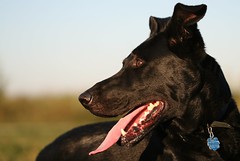Here is a really helpful write up from Muddyboots Photography Blog with a link to a helpful simulator for shutter speed and aperture.
**
Exposure & your light meter:* Exposure means how bright or dark your photo is.
* "Correct" exposure means that the photo came out as dark or light as you intended.
* The light meter on your camera will show you your exposure.
* The light meter on your camera looks like this:
[-2...-1...0..+1..+2]
* "0" on your light meter usually gives you a "correct exposure".
* Exposing for positive numbers like "+1", "+1.5", "+2", etc will make the photo BRIGHTER.
* Exposing for negative numbers like "-1", "-1.5", "-2", etc will make the photo DARKER.
Aperture:
* Aperture adjusts how large of an opening your lens makes to let light in.
* Small numbers like f/4 = larger opening = more light = a more shallow depth of field
* Large numbers like f/20 = smaller opening = less light = a deeper depth of field
* Depth of field means how much of the photo is in focus. See examples below:
Shallow depth of field:

(click for larger version)
Deep depth of field:

(click for larger version)
Shutter Speed:
* "500" in the viewfinder means a shutter speed of 1/500
* Shutter speeds of 1/60th or less can't usually be handheld, put your camera on a tripod
* For telephoto lenses, even faster shutter speeds are needed to handhold the camera, a rule of thumb is for a 100mm lens you need 1/100 or faster, 300mm = 1/300 or faster, 500mm = 1/500 or faster, etc.
* 1/6 or 1/8 is good for blurring waterfalls
* 1/125 can be used for panned shots of cars
* 1/500 will stop most action
* The slower your shutter speed, the more light you get.
* The faster your shutter speed, the less light you get.
ISO:
* ISO determines how fast your image is recorded
* ISO 100 will record light the slowest (less light)
* ISO 800 will record light 8x faster than ISO 100 (more light)
* Higher ISO's will result in more noise or "graininess" in your image.
Each setting effects the rest. Once you find settings that give you a "correct" exposure ("0" on your exposure meter), you can change your settings to find a more "creatively correct" exposure.
If you change the aperture from f/4 to f/5.6 you'd be SUBTRACTING light by 1 stop. You could ADD back a stop of light by increasing the ISO from 100 to 200, or by choosing a slower shutter speed like 1/30 instead of 1/60.
**
I think these 2 are really great guides that I will be printing and keeping in my camera bag so I can keep them handy. Hopefully these are just the thing I need to step up my photography! (That and light, damn you winter for coming back, again!)

No comments:
Post a Comment